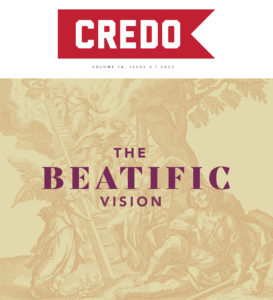The visio dei—vision of God—or often rendered as the beatific vision consists of seeing God. The beatific vision consists of living, experiencing happiness, and true blessedness. The beatific description of one’s vision corresponds to the Latin term, beatus, which is rendered as makarios in Greek and asher in Hebrew. The vision consists of one’s sight of God. The beatific vision is a beholding of God that renders life and happiness, and provides fullness, perfection, and flourishing for the one who sees. Moreover, this visio dei becomes ingrained in the Christian interpretive imagination based on the New Testament and the theological creativity of Augustine. According to Severin Kitanov,
The concept of beatific enjoyment is a theological, not a philosophical concept; it is the concept of religious, not secular enjoyment. Based on New Testament allusions to the indescribable experience of heavenly bliss in the presence of God, the concept of beatific enjoyment became a staple of Christian systematic theology thanks to Church Father and Saint Aurelius Augustine. St Augustine developed the concept both as a way of giving a teleological orientation to Christian learning and as a way of distinguishing the Christian ideal of heavenly beatitude from rival philosophical — Neo-Platonic and Stoic — conceptions of human flourishing.[1]
“Blessed are the pure in heart,” as Jesus instructs, “for they will see God” (Matt. 5:8). For Augustine, the beatific vision or beatific enjoyment is somewhat distinct from his contemporary philosophers, only experienced in the pure sight of God, anchoring the happiness of one’s life, partially felt now, and eternally realized in heaven.[2]
For Augustine, the beatific vision is only experienced in the pure sight of God, anchoring the happiness of one’s life, partially felt now, and eternally realized in heaven. Share on XIn On the Happy Life, Augustine begins a dialogue with the following sentiment: “We want to be happy.” Before finishing this statement, Augustine expresses how these dialogue partners concur and agree “with one voice.” Regarding happiness, much has not changed. If we begin to consider our Christian life, I am certain we still want happiness to mark our lives. I want to be happy; I do not want to be sad. I want fullness and joy and happiness. Augustine rehearses these comments from a philosophical heritage on happiness. Happiness is the “highest of all goods” and is the category that “most people virtually agree” (Nic. Eth. 1.4). As Aristotle continues, happiness is “living well and doing well,” even though many cannot agree on what this happiness might be. In the first century CE, the Stoic Philosopher, Seneca the Younger, begins On the Happy Life: “Everyone, brother Gallio, desires to live happily but are dull at perceiving exactly what is it that makes life happy.” Aristotle, Seneca, and Augustine each point to this universal principle: all want happiness, but not all are able to draw out what true happiness might be.
Whereas Augustine captures an ordinary reality (i.e., universal happiness), he anchors this happiness in the sight of God. The beauty of God draws Augustine away from his self-infirmities. However, the perpetual gaze upon God remains impossible: “I was astonished to find that already I loved you, not a phantom surrogate for you. But I was not stable in the enjoyment of my God. I was caught up to you by your beauty and quickly torn away from you by my weight” (Conf. 7.17). The ontology of God and beauty initially prompts Augustine’s vision of God. And yet, Augustine cannot remain “transported,” so to speak, in the presence of God simply because of the weight of his interior life.
The eschatological vision in the City of God is marked by both incomprehensible descriptions and a vision of God face to face (Civ. 22.29–30). When quoting 1 Corinthians 13:9 and 12, and Matthew 18:10, Augustine considers the heavenly vision of angelic sight. As angels are currently in heaven, they already see God. When we are delivered from the domain of darkness, given the Spirit, we become “fellow citizens” with the angelic realm. He quotes Matthew 18:10 and focuses on the phrase, “their angels in heaven always behold the face of my Father in heaven.” When we arrive in heaven, we possess the “vision” that John describes in 1 John 3:2 (“when he appears, we will be like him, for we will see him just as he is”) because, as Augustine comments, “By ‘the face’ of God we are to understand His manifestation, and not some part of the body such as we have and which we call by that name.” So, if we were to ever “blink” our eyes in heaven, there would still be no moment that our gaze upon God has ceased.
As Augustine moves towards different topics in Civ. 22.30, he intersects happiness, virtue, and the chief good of having God. Thus, in heaven, glory will be undiminished and true glory. Honor will never be denied. And the peace of God will have full reign. The greatest of all virtues received will be the very Giver of virtue, God. Furthermore, all of one’s happiness will be satiated in one’s perpetual sight of God: “God will be the end of our desires. He will be seen without end, loved without sting, praised without weariness. And this duty, this affection, this employment, will, like eternal life itself, be common to all” (22.30). In the culmination of one’s life and a person’s experiences in heaven, they will have perpetual sight of God that will satiate all desires and insufficient earthly expressions.
As Augustine concludes his dialogue in On the Happy Life, he intersects Trinitarian presence with the happy life: “This, then, is the full satisfaction of souls, this is the happy life: to know piously and perfectly Him by whom you are led to the Truth, whereby you may thoroughly enjoy the Truth, through which you may be joined to the Supreme Measure.” Michael Foley interprets the features of Truth and Supreme Measure as the Trinity. He comments: “That is, the Holy Spirit, who leads us to the Truth (see John 16:13); the Son of God, who is the Truth (see John 14:6); and God the Father, the Supreme Measure to whom we come or are united through His Son (John 14:6, Eph 2:18).”[3] The happiness of a person is the quest for God and experiencing God: “How then am I to seek for you, Lord? When I seek for you, my God, my quest is for the happy life” (Conf. 10.20). Furthermore, the authentically happy life is when one’s joys are grounded in God and caused by God (Conf. 10.22). As he concludes Book 11, he states: “Heal my eyes so that I can share in the joy of your light” (Conf. 11.31).
It remains uncertain, for Augustine, if everyone really wants a happy life because all happiness is anchored in God through experiencing, seeing, and remembering God. Augustine’s Epistle 147 To Paulina is also entitled “The Book on the Vision of God,” whereby Augustine offers a dogmatic reading of Matthew 5:8. In several places in this letter, he situates the non-corporeality of sight but focuses on the inward reflection of God as spiritual sight: “We believe that God is seen in the present life, but do we believe that we see Him with our bodily eyes, as we see the sun, or with the gaze of the mind, as everyone sees himself inwardly, when he sees himself living, wishing, seeking, knowing or not knowing” (Ep. 147.3)? Augustine likewise comments on the invisible God and yet the pure in heart are able to see God. He strings together several scriptures that render the seemingly visible qualities of God: “That ‘God is light and in him there is no darkness’ (1 John 1:5); and that ‘with him there is no change nor shadow of alteration’ (Jas 1:17); and that ‘He inhabits light inaccessible, whom no man has seen nor can see’ (1 Tim. 1:16); and that the Father and the Son and the Holy Spirit are one God, without any diversity or separateness of nature, and the clean of hear will see him (Matt. 5:8); and that “God is charity and that he abides in charity, abide in God and God in him’ (1 John 4:16)” (Ep. 147.46). These selected scriptures, for Augustine, display that those who have made spiritual have access to spiritual things and that “mental sight is superior to bodily sight” (Ep. 147.46). Happiness is the complete delight and satisfaction of the soul with the presence and vision of God. Share on X
What, then, is happiness? Happiness is the complete delight and satisfaction of the soul with the presence and vision of God, which is achieved today through one’s memory and will one day be fully realized in heaven. Delighting in God is the happy life. Seeing God is the happy life. In one’s union with God, happiness, sight, and memory is the basis for contemplation. I close with this summary from Augustine: “For the fullness of our happiness, beyond which there is none else, is this: to enjoy God the Trinity in whose image we were made” (Trin. 1.9.18). According to Lewis Ayres, Augustine describes his non-corporal vision as “only at the end of the process of purification, and this clear sense of such contemplation may allow him to focus the distinction between faith and sight with peculiar clarity.”[4] The visio dei consists of the blessed, happy life that brings about human flourishing. A Christian’s delight and central affection are beholding God after their souls have been purified by God and will await final, unencumbered sight in heaven.
Endnotes
[1] Severin Valentinov Kitanov, Beatific Enjoyment in Medieval Scholastic Debates: The Complex Legacy of Saint Augustine and Peter Lombard (Lanham, MD: Lexington Books, 2014), xiii.
[2] In this summary, I do not include any discussion about Augustine’s spiritual journey in his Confessions as he struggles to comprehend God. That God is simple and non-corporeal added to Augustine’s misery. And in his transformation, his vision of Godincreased as he contemplated God. This idea is attributed to Coleman Ford, who offered comments to an earlier version of this article.
[3] Michael P. Foley, trans., St Augustine’s Cassiciacum Dialogues: On the Happy Life, vol. 2 (New Haven, CT: Yale University Press, 2019), 150n158.
[4] Lewis Ayres, Augustine and the Trinity (Cambridge: Cambridge University Press, 2010), 150.


